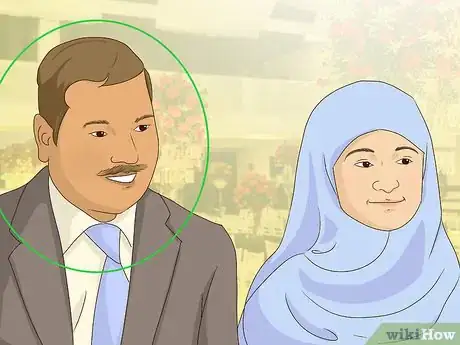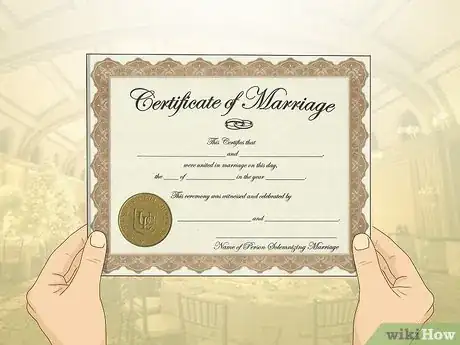This article was co-authored by wikiHow Staff. Our trained team of editors and researchers validate articles for accuracy and comprehensiveness. wikiHow's Content Management Team carefully monitors the work from our editorial staff to ensure that each article is backed by trusted research and meets our high quality standards.
wikiHow marks an article as reader-approved once it receives enough positive feedback. In this case, 91% of readers who voted found the article helpful, earning it our reader-approved status.
This article has been viewed 334,602 times.
Learn more...
The nikah is the traditional Islamic marriage ceremony. The nikah has 3 main components: a willing couple, witnesses, and a mahr, or gift that the groom gives to the bride. Once you have these things in order and find an imam to perform the ceremony, you will be well on your way to having a successful nikah.
Steps
Planning the Ceremony
-
1Agree to get married. The cornerstone of a nikah is a mutual agreement between two people to get married. Prospective spouses should fully discuss getting married before making any arrangements. If you want to be traditional, you may also have a formal proposal of marriage and consult your parents to make sure they approve.[1]
- Some mosques and imams may not perform nikah without the presence of parents or guardians, so parental approval may be especially important if you want to perform nikah in a more conservative mosque.[2]
-
2Find an imam to perform the ceremony. If you attend a mosque regularly, simply ask one of the imams there to perform nikah for you. If you do not attend a mosque regularly, search for imams in your area who perform nikah ceremonies. You may have to pay a fee for this service.Advertisement
-
3Find a space to hold the ceremony, preferably a mosque. Nikah can technically be held anywhere, so you can arrange to have the ceremony in your home, a banquet hall, or any other space you’d like. If you want to be traditional, though, hold the ceremony in a mosque
-
4Agree on a mahr. Mahr is the traditional gift that the groom gives to the bride when entering into marriage. The gift is traditionally a sum of money, but it can also be property or objects. It is meant to be a symbol of the groom’s commitment. There is no minimum or maximum mahr, and it is usually determined based on the finances of the groom.[3]
- Traditionally, the bride and her family have a say in the mahr because it is meant to give the bride some independence in marriage by enabling her to have money of her own.[4]
- The bride and groom should determine what they want the mahr to be before the nikah.[5]
- The couple can agree to have the mahr given during the nikah or at a later date.[6]
- While traditionally mahr is money or something the groom buys, you can be creative if you’d like. Some grooms have made their mahr's specific acts of commitment, like memorizing the bride’s favorite verses of the Quran and reciting them during the Nikah.[7]
-
5Find at least 2 adult muslims to witness the ceremony. Traditionally, these 2 witnesses need to be men. Ask the imam performing the nikah what their requirements are for witnesses. Some imams may allow women to serve as official witnesses. These witnesses are usually family members or close friends.
- If you are unable to find muslim witnesses, ask your imam if it would be possible to have non-Muslims witness your nikah. Some imams may be more flexible than others.
-
6Ensure that the bride has a guardian present if you want to be traditional. Some traditional mosques require that the bride’s father, brother, or other male guardian be present to give her away to the groom. Ask the imam performing your ceremony if they require this
-
7Obtain an official marriage license from your local government. Contact your local government or city hall to learn about this process in your area. A marriage license will make your marriage legal and recognized by civil authorities. Some mosques and imams may require you to have your marriage license before they perform nikah.
Holding the Nikah
-
1Have the imam give a marriage sermon if you want to follow tradition. There are traditional sermons on marriage that imams often give during nikahs. These usually involve specific prayers and readings from the Qur'an. If you have specific requests about the sermon, bring them up with your imam.
- For example, you might ask the imam to read specific passages from the Qur'an that are meaningful to you.
-
2Have a traditional proposal and acceptance if desired. Traditionally, the imam has the father ask the groom if he will accept his daughter in marriage. Tell your imam if you would like to do this during your nikah. If you do have this part of the ceremony, the imam will usually instruct all parties what to say and when.
-
3Sign the Nikah contract in front of your witnesses. This will make the union official. Sign it in front of just your 2 official witnesses, or in front of all of your guests. Depending on the mosque or imam, the witnesses may or may not be asked to sign the document as well.[8]
-
4Hold a walima or marriage banquet if desired. This generally follows the nikah and gives the new couple a chance to celebrate their nikah with their guests and members of the community. If you invite people to witness your nikah, it will generally be expected that you will hold a walima afterwards. It does not need to be lavish, but you should make sure you provide enough food for all of your guests.[9]
Community Q&A
-
QuestionIf the bride wants to go to her parents' house for 4 to 5 hours after the nikah in the mosque, can the groom come to the bride's house?
 SobiTop AnswererAfter the nikah, the couple are now, Islamically, officially married. They are allowed to be together.
SobiTop AnswererAfter the nikah, the couple are now, Islamically, officially married. They are allowed to be together. -
QuestionI have no male relatives and am a revert. Who can act as witness for me?
 MudarroCommunity AnswerContact an imam at a local mosque; tell him your situation. He will act as your wali.
MudarroCommunity AnswerContact an imam at a local mosque; tell him your situation. He will act as your wali. -
QuestionIs my nikah still valid if my maternal uncle gave me away in marriage and my paternal uncle witnessed the whole process?
 Community AnswerOf course! Allah understands why you may have chosen to do this and accepts all.
Community AnswerOf course! Allah understands why you may have chosen to do this and accepts all.
References
- ↑ https://www.soundvision.com/article/an-nikah-the-marriage-covenant
- ↑ https://www.soundvision.com/article/an-nikah-the-marriage-covenant
- ↑ https://www.soundvision.com/article/an-nikah-the-marriage-covenant
- ↑ https://www.soundvision.com/article/an-nikah-the-marriage-covenant
- ↑ https://www.soundvision.com/article/an-nikah-the-marriage-covenant
- ↑ https://www.soundvision.com/article/an-nikah-the-marriage-covenant
- ↑ https://www.zawaj.com/best-mahr-world/
- ↑ https://www.soundvision.com/article/an-nikah-the-marriage-covenant
- ↑ https://www.soundvision.com/article/an-nikah-the-marriage-covenant
About This Article
To perform the nikah as a part of a traditional Islamic marriage, start by obtaining an official marriage license from your local government. Then, find a mosque to hold the ceremony, an imam to perform it, and at least 2 adult Muslims to serve as witnesses. If you want to be especially traditional, ensure the bride has a guardian present, as well. Next, you'll need to agree on a mahr, which the groom will gift the bride as a symbol of his commitment. Although a mahr is traditionally a sum of money, the groom could show his commitment in other ways, like reciting the bride's favorite Quran verses. Once the imam gives the marriage sermon, sign the nikah contract in front of your witnesses to make your union official. For more tips, including how to hold a walima or marriage banquet, read on!




































































